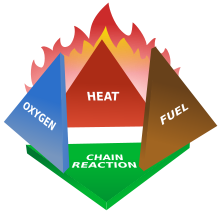
|
|||||||
| HOW FirePro® WORKS IN A FIRE | FirePro® aerosol extinguishes fire by inhibiting the chain chemical reactions present in combustion on a molecular level. |
||||||
| Theory of Fire – Fire Extinguishing: Traditionally, there were three distinct elements assumed as necessary for combustion: heat, fuel and oxygen, popularly known as the “fire triangle”. Typical fire extinguishment involves either removing the fuel from the fire, limiting oxygen to the fire (smothering) or removing the heat (quenching).
This theory had to be modified as other agents like FirePro do not extinguish fire in any of these ways, but instead break up the chain reaction of the combustion process. Upon activation, FirePro starts a chemical reaction that in few seconds produces aerosol i.e. potassium compounds (K2CO3), H2O, N2, CO2 and other gases in small quantities. FirePro remains in suspension for a relatively long time in the protected volume allowing it to flow into the combustion core breaking the chain reaction upon flame contact with extremely high efficiency. |

|
1. Fire is a series of chemical chain reactions. The flame free radicals (O2,H+,OH–) act as chain carriers, sustaining the flame until atlease one of these three elements of the fire is completely depleted.
2. In the presence of fire, the potassium carbonate(K2CO3) which is the active agent in the condesed aerosol medium undergoes thermal dissociation, forming unstable potassium free radicals (K*) which act as chemical chain reaction inhibitors. 3. Chain termination occurs when K* are bound to the flame free radicals by forming stable potassium hydroxide(KOH). 4. KOH reacts further in the presence of CO2 to form potassium carbonate (K2CO3). The cycle continues until the chemical chain reaction terminates and trhe fire is extinguished. |
|||||
| HOW FirePro® works on extinguishing the Lithium Polymers batteries Fires | |||||||
| Common electrolytes contain lithium hexafluorophosphate salt (LiPF6). LiPF6 is highly flammable and undergoes thermal decomposition when the Li-ion cell is exposed to increased temperatures. The decomposition of LiPF6 is promoted by the presence of water or humidity, according to the following reactions: | |||||||
| when heated in a dry and inert atmosphere | LiPF6 → LiF(s)+PF5(g) | ||||||
| in the presence of moisture, PF5 is further reacted to form POF3 and HF | PF5 + H2O → POF3(g)+2HF(g) | ||||||
| when heated in normal atmosphere in presence of moisture | LiPF6+H2O → LiF(s)+POF3(g)+2HF(g) | ||||||
| During a battery fire and explosion, the gases formed by the thermal breakdown of LiPF6 salt solutions are toxic (HF, POF3). High concentrations of HF were detected in fire tests. The POF3 concentration was below the detection limit. Extensive research has been carried out to eliminate the amount of HF or to further neutralize it with alkaline materials. Fire extinguishers that contain aqueous solutions of metal salts have proven to be effective, through a mechanism where the metal ions bind to the HF gas molecules to form stable solid metal fluorides.[*] FirePro is a technology for suppressing Li-ion battery fires, thus the main components of the fire extinguishing aerosol are alkaline potassium salts. Both the active agent K2CO3 and KOH intermediate product react with HF to form stable products, according to the following reactions: |
|||||||
| K2CO3 + 4HF → 2KHF2(s) + CO2 + H2O | KOH + HF → KF(s) + H2O | ||||||
| As a result, this neutralization allows the room temperature to lessen significantly below 120°C, the threshold temperature below which the thermal reaction within a Li-on battery will stop. | |||||||
| [*] Patent No.: US20120312562A1, Method for fighting and/or preventing fires in lithium ion cells and lithium ion polymer cells. | |||||||
